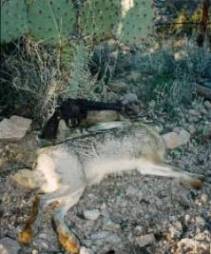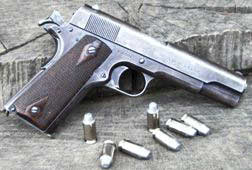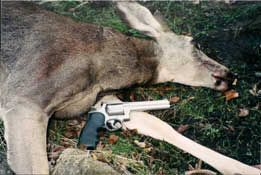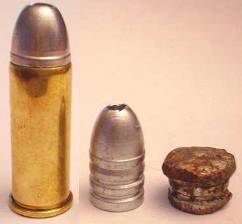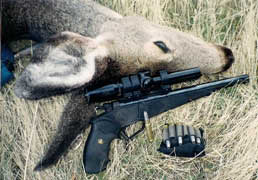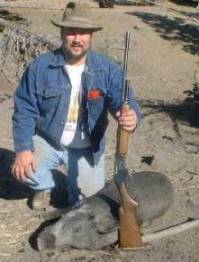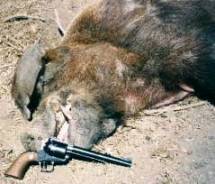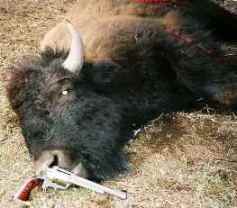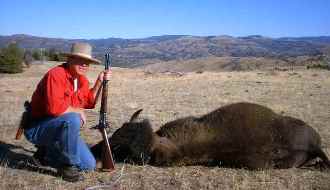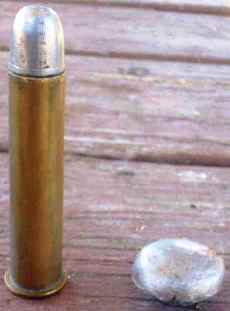|
|
||||||||||||||||||||||||||||||||
|
Chapter 15 |
||||||||||||||||||||||||||||||||
|
Handgun Hunting with Cast Bullets |
||||||||||||||||||||||||||||||||
|
I stood atop the basalt rimrock, 2000 feet above the mighty Snake River, but I could have been standing behind a barn in an Indiana cornfield for all I could tell. The fog was patchy and blowing, and the canyons below me looked as though they had been cast to the brim with a milky white alabaster. It was, mid-November, a little after sunrise, cold and damp. I knew that there were 8 or 9 mule deer in the canyon below me, with 3 good bucks in the group (I had been following them for almost an hour), but where were they? They could have been 20 yards away and I would have no way of knowing. I pondered my options as the fog condensed onto and dripped from the brim of my favorite hunting hat. As though delivered by some divine nostril, a blast of crisp, cold air swept the fog from below me, revealing the carefree band of mulies only 35-40 yards down canyon. My scoped Contender came to bear on my chosen target, and I swore silently as the heavy condensation ran from both lenses of the scope, obscuring all hope of making a shot. A dry bandana was quickly extracted, and the lenses blotted to some vague semblance of dryness, but my movements were too much for the deer's comfort and the window in the fog too short-lived. The fog closed in and the now spooked bucks disappeared into it, not to be seen again for the rest of the season. My opportunity had been presented and I had failed to make good on it. An iron-sighted revolver has been my preferred damp weather hunting tool ever since. These revolvers are invariably loaded with cast bullets. What are the best cast bullets for handgun hunting? What issues are important, and which designs are best suited for what classes of game? To answer these questions, let's look at the physics and physiology of the bullet's impact. How Does a Bullet Kill? Big guns kill big critters, so a big gun is going to absolutely disintegrate a smaller species, right? A common misconception is that if a gun/load/bullet is well-suited for quickly and cleanly killing a charging 1000-lb grizzly, then it will kill a 150-lb whitetail even faster and more dramatically. Sure, it’ll kill the deer eventually, but that little whitetail may run a whole lot farther than the grizzly, and may very well be lost. Does that mean the dainty Southern whitetail is that much tougher than a huge coastal grizzly bear? Not hardly. It just means that the wrong bullet was sent to do the job. In the ads for specialty hunting bullets we see terms like “rapid expansion”, “controlled expansion”, “deep penetration”. What’s best? What do we want for hunting? How do we cast our bullets to deliver optimum hunting performance? Well, that depends on what we’re hunting. A bullet kills by crushing soft tissue, rupturing blood vessels, inducing hemorrhage, ultimately reducing the blood pressure to zero, thereby denying the brain of oxygen. Unconsciousness and death quickly follow. How quickly the blood pressure drops to zero depends on how much tissue is crushed and how quickly blood flows out of that tissue (which is directly related to how much blood flows into that particular organ). The key concept here is that of wound volume -- the total number of cubic inches of soft tissue that are left crushed and bleeding by the passage of the bullet. Blood has to leak out of the cardiovascular system from somewhere, and it has to have somewhere to go. The larger the volume of the wound the more tattered tissue is left along the periphery for the blood to leak out of, and the greater the wound volume the more space the blood has to flow into. An exit wound also helps to drain the blood, by giving it somewhere to go. Hydrostatic shock Let’s deal with a couple ill-defined and over-used buzz-words. “Hydrostatic shock” is held in almost mystical regard by some shooters. What is hydrostatic shock? High velocity bullets tend to have a larger diameter wound channel than just the tissue crushed by the bow wave of the bullet as it passes through (the bullet is generally less than 1” in diameter and the bow wave that sets up in front of the bullet will usually crush 2-3” of tissue, hydrostatic shock can rupture blood vessels in a foot or more of soft tissue). The British military performed extensive ballistic and forensic studies after World War I (back in the days when "high velocity" was all new and shiny and exciting and different) and found that “hydrostatic shock” became a significant issue when the bullet's impact velocity was greater than about 2600 fps. OK, let’s do some simple analysis. The speed of sound in air is roughly 1000 fps, the speed of sound in water is roughly 4000 fps. If we assume that the vital zone of a typical game animal is approximately equal parts air (the volume of the lungs) and water (the primary component of the surrounding soft tissue), and further approximate that the speed of sound in mixed media is simply a weighted average of that of its components, then the prediction is that the “speed of sound” in the vital zone of yon critter is going to be roughly 2500 fps, quite similar to the point that the Brits started to note the presence of this mysterious phenomenon they called “hydrostatic shock”. Hydrostatic shock is the result of a high speed pressure wave that ruptures blood vessels, greatly increasing the amount of hemorrhaging in the wound channel. In a nutshell, it’s a sonic boom traveling through living tissue. As the bullet passes through the vitals of an animal going faster than the speed of sound (that is, the speed of sound in that particular tissue), the “sonic boom” helps to rupture blood vessels and crush tissue. As the bullet slows down to below the speed of sound (again, the speed of sound in that particular tissue) this pressure wave collapses, and the wound channel beyond this point becomes the traditional (sub-sonic) wound channel. This behavior is obvious when one observes wound channels in homogenous media like ballistic gelatin, especially with rapidly expanding bullets (i.e. those that tend to slow down rapidly) that retain significant mass, like the Nosler Partition. Inspecting the ballistic gelatin wound channels of these bullets, one sees a large cantaloupe-sized cavity just beneath the surface, which later collapses to a long, narrow channel. This collapse takes place when the bullet slows down below the speed of sound in that particular medium. It is important to recognize that ballistic gelatin has a different density (and hence a different speed of sound) than does the vital zone of your typical buck, so the size of each of these features and the point where the bullet slows to below the speed of sound will be very different in the buck’s vital tissues than in the denser ballistic gelatin. It is also important to recognize that hydrostatic shock is only delivered very early in the bullet’s impact, while it is still moving very fast. This mode of tissue destruction drops off very quickly as the bullet slows down. So, if you have a large muscular beast with lots of hide, muscle and bone between the entry point and the vitals (e.g. Cape buffalo, grizzly bear), hydrostatic shock isn’t likely to play any role at all because the bullet has slowed down to below the speed of sound (in soft tissue) by the time it reaches the vital organs. But a smaller animal with relatively little meat between the outer skin and the vitals (e.g. pronghorn antelope) is more prone to fall over as if electrocuted when shot with the latest hyper-velocity Eargesplittenloudgeboomer. The reason is simple, the bullet is still traveling at supersonic (soft tissue supersonic) speeds as it traverses the vital organs. A point that is commonly ignored is that hydrostatic shock causes bloodshot meat (although it's not the only mechanism that causes meat to become bloodshot), which helps to explain why moderate velocity rounds like the .30-30 Winchester, .35 Remington, .444 Marlin and .45-70 are so popular with “meat hunters”. Since the focus of this book is on cast bullets and since cast bullets are almost always used at velocities below 2600 fps, hydrostatic shock can be largely ignored. This 2600 fps is not a fixed number because each species is built differently, and each animal has a different amount of breath in its lungs when the bullet hits, and each shot presentation involves different tissues of different densities. This number undoubtedly varies several hundred fps, depending on the prey species, shot presentation, elevation, etc. However, the concept of supersonic impact and its relationship to the nature of the wound channel is nonetheless important for higher velocity jacketed bullet loads. The bottom line is that hydrostatic shock can play a significant role in how the .25-06 kills, it’s probably not much of a contributor for the .44 Magnum. Penetration vs. Expansion For a given power level (e.g. .44 Magnum), changing the cast bullet’s hardness or bullet design will have a direct impact on the bullet’s ability to penetrate. The softer a cast bullet is, the more it can expand, leading to broader wound channels and less penetration since part of the kinetic energy is being used to deform the bullet metal, and the bullet is crushing a wider path through the meat. The harder a cast bullet is, the less it will deform and the deeper it will penetrate. As penetration depth increases, wound channel diameter tends to decrease. Said another way, any given bullet is capable of crushing only so much tissue (i.e. converting it's kinetic energy into the work of crushing/displacing tissue), and it can expand quickly and make a short, wide wound channel, or it can expand not at all and make a long narrow wound channel. The vital zone on each animal is of different size and the hunter needs to take this into consideration when choosing a bullet design, alloy and load. The nature of the wound channel needs to be matched up with the vital zone dimensions and shape of the animal being hunted. It is up to the hunter to make sure the bullet’s construction is appropriate for the prey species, and to then place that wound channel where it can be most lethal and humane. Tailoring the bullet to the quarry. The obvious issues involved in matching the bullet to the quarry are bullet weight and diameter, but the caster also has the advantage of being able to specifically tailor his bullets by varying alloy hardness and HP cavity diameter and depth. OK, so what sort of wound channel works best for big game? For any game animal, it’s important that the wound channel not only reach the vitals but go all the way through them (again, it’s good if the blood has somewhere to go). As a result, penetration depth is critical for large and dangerous game. This means that the bullet can’t waste its energy distorting the bullet metal and slowing down too early (i.e. expanding). All the work must be used to crush tissue, none to deform the bullet. Thus, the blunt-nosed non-expanding solid bullet that is favored for this type of hunting produces a long wound channel that tends to be fairly narrow, but added up over its total length of many feet, this creates a significant amount of wound volume. However, if this same load is used on a pronghorn antelope, the bullet punches through from side-to-side with the same narrow wound channel (assuming no major bone is hit), but since the antelope is a much smaller animal, this shorter wound channel results in significantly less tissue damage than it does on larger game, and the antelope may run quite a distance before eventually succumbing to it‘s modest wounds. Smaller animals don’t generally need 4-8 feet of penetration, 18-24” is usually adequate, and therefore an expanding bullet generally results in a much quicker kill than does a non-expanding solid, as a result of the larger wound diameter (and hence wound volume) produced by the expanding bullet. When hunting with a handgun, this becomes particularly important. Notable handgun hunters like J. D. Jones, Hal Swiggett, John Taffin, Mark Hampton, and others, agree that while heavyweight solid flat-pointed bullets are desirable when pursuing large, dangerous game, that some sort of expanding bullet is usually a better killer when pursuing lighter-bodied, thin-skinned game like deer and antelope. Rapid expansion. Hunting medium and small game is precisely where the cast HP comes into its own. It provides all the advantages of the cast bullet (longer barrel life, lower pressures, higher velocities, the pride of making your own hunting projectiles, etc.), along with the enhanced lethality of the expanding JHP, as well as the weight retention of the specialty high performance bullets (e.g. partition). The lighter, more frangible cast HP's (e.g. those for the .30 Carbine, .357 Magnum, etc.) are superbly suited for sixgunning varmint hunter, while the heavier, larger caliber cast HP's (e.g. those for the .44 Magnum, .45 Colt, etc.) are excellent for deer and antelope sized game. Controlled expansion. Larger animals, like elk and moose, call for a heavier, more stoutly constructed bullet, like the .300+ grain designs available for the .44 Magnum, 454 Casull and .480 Ruger. Expansion of the cast bullet is fine in these cases, but it needs to be a more moderate, controlled expansion than a hollow point delivers to insure that the bullet digs deep. Controlled expansion can be attained by using one of the fine hunting moulds (e.g. Keith SWC, SSK FP, LBT WFN/LFN, etc.) and casting the bullets with a soft enough alloy to allow for modest expansion at the expected impact velocity (e.g. BHN of about 12 for typical .44 Magnum velocities). This approach sacrifices very little in the way of penetration depth, and can provide the hunter with a slightly wider wound channel. This level of penetration is far more than needed for deer, but it can be useful for "Texas heart shot" presentations. For loads in this category, I normally cast these bullets using air-cooled wheelweight alloy (or something similar), and they are very well-suited for elk. Non-expanding solids. Large, dangerous game animals (e.g. Cape buffalo, the big bears, etc.) have their vital organs shielded by thick layers of dense muscle and heavy bone. A cast bullet must be hard and heavy (300 grains at a minimum, and preferably more) to reliably make it through this obstacle course to perforate the vitals. Bullet impact on these heavy bones can cause deformation that may lead the bullet to veer off track and miss the vitals completely. In this case, the bullet needs to be both hard and tough. One common method used to address this need is to cast the bullets from straight linotype (BHN = 22), but this approach suffers from the drawback of increased brittleness and possible fragmentation. While I have never hunted Africa (I hope to someday...), extensive research by a number of handgun hunters who have suggests that the best bullet metal for large and dangerous game is water-quenched (or heat treated) wheelweight alloy. This bullet metal is not only hard enough to resist expanding at handgun velocities (BHN of 16-18), but the modest antimony content (ca. 4%) also means that this alloy is tough, and resists fragmentation. Excellent penetration is obtained, and bullet deformation is negligible. For those who want their bullet a little harder, this alloy can be “sweetened” with as much as 20% linotype before any brittleness problems arise (again, these bullets are water quenched from the mould). Cast bullets in the hunting fields
Varmints. I have burned countless thousands of rounds of ammo all over the western US in pursuit of various “flavors” of vermin over the years. Sometimes the weather is hot and dusty, sometimes cold and foggy, but the guns I’m carrying are almost always loaded with cast bullets. For example, several years ago I was in southeastern Arizona hunting Javelina. As the trip wound to a close, I was able to spend a memorable afternoon hunting jack rabbits with a favorite 5-screw K-38 Masterpiece, loaded with Elmer Keith‘s 358439 at 1000 fps. It was mid-February and the afternoon was cool and cloudy, and the scent of sage flavored what little breeze there was. I kicked up the first jack shortly after leaving the truck, and he ducked and dodged his way through the sagebrush as only a jack rabbit can. He came to a stop about 35 yards out, tucked into the shadows behind this one clump of sage, and sat there to watch me to see if I amounted to any kind of threat. Classic bunny stance, broadside, facing my left. The Patridge front sight of the K-38 Masterpiece slid under the “armpit” of the rabbit as I mentally pictured a 6 o’clock hold on an imaginary bullseye on his shoulder. Just as I dropped the hammer, I remembered that the gun was sighted in for a 6 o’clock hold....but only when using wadcutter target loads. When loaded with these +P cast HP’s it was sighted in for a center hold! Aarrgh! The results downrange confirmed my fears -- white fluff erupted everywhere, in a 6-8 foot explosion. The rabbit ran off, absolutely terrified, but clearly in excellent physical shape. I inspected the scene thoroughly and found only tufts of white fur, no sign of any meat or blood. I pursued the rabbit, and saw him several more times (with his shaved armpits he was easy to identify), but was never able to get a second shot at him. We parted ways, him fashionably coifed, me chastising myself. A few minutes later, I kicked up a second jack (this one larger, and medium brown), he ran about 40 yards and hid behind a clump of sage. There just so happened to be a small window through the scrubbrush and I threaded one of Elmer’s finest through that narrow window into the center of the rabbit’s shoulder. It landed with an audible “thump!”, and punched though leaving a gaping exit wound in its wake. Mr. Keith certainly designed good bullets.
There was another jack rabbit that was memorable, this one in central Montana. A group of us had spent a hot July day out shooting prairie dogs, and we were headed back to town to get a hot meal and a cold beverage (or two). We were a good 20 miles from the nearest paved road, in the middle of nowhere, when a very large jack skeedaddled across the road, right in front of the car. I asked Reo to stop the car, and I got out, loading my 1918 vintage Model 1911 as I went. The jack had stopped to hide in a thick clump of sage, but when I dropped the slide home, he took of running again, cutting a wide arc across the Montana plains. I swung the old warhorse 1911 to lead him, and at each window in the sage, 4.0 grains of Bullseye launched an Ideal 452460 200 grain SWC off in the direction that long-eared pin-ball. I guess this rabbit thought that I was shooting a revolver, because after missing him 6 times, he stopped about 100 yards out to catch his breath and look me over. I knew from previous experience with the fine battlefield sights on this WWI 1911 that it was spot on point of aim at 25 yards or so, and with this load when the base of the front sight was held on the top of the rear sight, that it was spot on at 100 yards. With the sight picture so configured, and my last round in the chamber, I centered that needle-fine front sight on this husky jack and let fly. With a hollow “thwock!” (and no dust cloud to indicate a miss) the jack slowly and stiffly fell over backwards, as though he were a silhouette cut from 1/4” steel plate, and then disappeared from sight! I reloaded and went to investigate. Turns out he was standing next to a truly monstrous prairie dog hole (almost 2 feet in diameter) and when he fell, he fell directly into the hole. There were several splashes of bright red blood, indicating a solid upper body hit. A small patch of rabbit fur was visible about 5 feet down into the dark recesses of the hole, but not wanting to tangle with any possible rattlesnakes, I didn’t investigate further. Several years ago, I was on my way back from some technical meetings and was able to stop off and spend a few days prairie doggin’ in south-central Wyoming. On one afternoon, my 629 Classic Hunter was loaded with Elmer’s 429421 HP at 1350 fps. In one area the landscape undulated like a giant washboard, and I could sneak up out of one gully and peak into the next, getting several shots in the 50-100 yard range. As soon as the critters in that gully got to spooked for me to get any more shots, I’d sneak over and peak into the next gully. That revolver spent most of that afternoon quite warm. Elmer Keith sure did design some fine bullets -- the 429421 HP expands well and it just flat hammers rodents. One of my favorite ways to spend a sunny summer afternoon is hiking around the mountains of the Pacific Northwest with a favorite revolver, in pursuit of ground squirrels. A few summers ago, we had a group of sixgunners getting together for a mountain rendezvous, varmint shoot and campfire gabfest. I got there early, to prep the campsite and to cut a weekend supply of firewood. As the early arrivals started to dribble in, I was describing the area to them and showing off the 400-500 yard stumpfield that we would be using as our plinking range. A rather portly ground squirrel (aka “greydigger”) chose that moment to hop up onto a stump, about 40-45 yards in front of us. Now when I’m cutting firewood, I wear my 3” S&W 624 Lew Horton .44 Special on my belt; this occasion was no exception, and it was loaded with 429421 HPs (cast soft, BHN about 8) over 7.5 grains of Unique for about 900 fps. As though on cue, one of the early arrivals asked, “What exactly do these greydiggers look like?”. I pointed over towards the rodent and said, “Well, there’s one right over there.” and as he was trying to pick it out from the stumps, the 624 came out and spoke its piece. The soft HP flipped the rodent and turned him inside out. “Nice shot.” came the drawn out response. That’s one of the reasons I like that revolver so much, it makes nice shots. The first time I encountered a Ruger Blackhawk in .30 Carbine, my only thought was “Why?”. This was back in the days before I started handloading, and all I was thinking of was shooting milsurp FMJ though it, and if you want to plink, why not just do it with a .22 or .38? They’re cheaper, quieter and more versatile. Well, now that I’m a handloader and bullet caster, I view the cartridge and the gun in a whole ‘nother light! Loaded with GC cast HP’s, the .30 Carbine Blackhawk can generate 1600 fps with superb accuracy, with a remarkably flat trajectory and some truly impressive terminal performance. This just may be the perfect varmint sixgun. I have a 3-screw Blackhawk in .30 Carbine that has made some very satisfying shots on ground squirrels. One afternoon Rob and I were hiking through the mountains. As we crested one ridge, we found a rather large digger sitting up on his stump, surveying his kingdom. A stiff charge of Accurate Arms #9 launched a 311316 HP down the hill, across the 80 yards between us. The impact was clearly audible, and expansion obvious, as he was launched several feet into the air, spinning in a triple backflip. “Wow, I gotta get me one a those....” was all Rob could say. The cast HP turns the .30 Carbine Blackhawk into a whole different gun.
Medium Game. For deer-sized game, I like the added wound-channel width delivered by an expanding bullet, so I commonly hunt using cast HPs, generally weighing 200 grains or more. For revolvers, these cast HPs are generally 40 caliber or larger. It's tough to beat the good ol' .44 Magnum as a cast bullet hunting round, but there are other fine rounds for game in this class, like the .401 Powermag, .41 Magnum, .44 Special and .45 Colt; they all do well with Keith-style SWCs and cast HPs on deer sized game. When I'm hunting with a Contender, these cast HPs are generally .33 caliber or larger. I'm partial to my own wildcat (the .338 GEF) for obvious reasons, but there are any number of other good rounds for game in this size range, including the .35 Remington, the .375 Winchester, .375 JDJ that also do well with suitable cast bullets. When hunting deer-sized game with rifles, I commonly just hunt using solids cast soft enough to expand at whatever velocity I'm shooting them at (or HPs at 1600-1700 fps). In this case, my preferred round is the .35 Remington or .35 Whelen. One such memorable morning started off crisp and cold, with a heavy frost on the ground, and the early morning colors slowly leaking into the gray rocky canyons of the Snake River. Shortly after sunrise, a mulie doe snuck into the basalt-lined canyon below me with a large yearling. I followed her with my revolver's sights as she moved across the hillside she heard the metallic "Snick" as I eased the hammer back to full-cock, and she skidded to a stop. She quickly turned back and led her yearling back across the hill, uneasy about her surroundings. About 35 yards in front of me, she stopped and was looking down canyon, straight away from me. The front sight blade settled on her spine, a little below her ear, and the .44 Magnum roared. The Lyman 429640 HP (at 1350 fps) went exactly where it was told and the doe folded on the spot. In the timeless words of one of my long-time hunting partners, "She bounced three times on the way to the bottom of the canyon". By mid-afternoon, I had the venison packed up and out of those rocky Snake River canyons and was back at camp enjoying a hot cup of coffee. I like the .44 Magnum, and the .44 Magnum likes cast bullets. I also like the .44 Special. On another hunt, I had already filled my bag and was just along for the ride while a friend of mine was looking to shoot a nice sized feral boar with his .45-70. We were working over a muddy hillside when we heard a deep grunt come from up the creek channel in the drainage below us. Steve made a nice stalk on this boar, and hit him with his .45-70, loaded with the 330 grain Lyman 457122 (the Gould HP) at about 1500 fps. He placed the shot well, breaking the left should and just missing the heart, but this was one tough old boar, and he wasn't go to go down easy (the bullet expanded well and exited, and it just missed the heart by a little bit). The boar got into some thick stuff and Steve wasn't able to get into position to shoot again. The boar wandered my way and came out of the brush about 10 feet in front of me. I had my 7 1/2" stainless Ruger New Model Blackhawk .44 Special that my good friend Dave Ewer built for me. It was loaded with the Lyman 429251 HP (BHN = 8) loaded over 17.0 grains of 2400 for 1235 fps. When the black-n-white boar stepped out of the brush, I put two quick shots into his ribs and though his lungs,
knocking him off his feet. Steve then came up and finished him off with his .45. One of my two shots exited, the other was found under the hide on the farside. Both had expanded nicely, and done significant damage to the lungs. The recovered 429251 HP had expanded to approximately .60 caliber and weighed 194 grains. Steve's boar weighed a little over 700 lbs on the hoof, and the skinned and gutted carcass weighed over 350 lbs.
Back in 1993, along with the help and guidance of the good folks at SSK Industries, I designed my own wildcat cartridge for the Contender, the .338 GEF. It’s based on the .356 Winchester case, necked down to .338 with the body taper blown out and a 40 degree shoulder. More recently, I converted a single cavity Lyman 33889 to drop HP bullets specifically for this wildcat. It weighs 245 grains when checked and lubed (WW alloy). The first load I tried put 3 shots into 1” at 50 yards. A late season doe tag was burning a hole in my pocket, so I took off for the breaks of the Snake River, outside of Pullman, WA. Dawn broke cold and gray over the basalt encrusted canyons of the Snake the next morning. I had worked my way down into one of my favorite canyons, and had nestled myself into a rock outcropping to break up my outline and get out of the biting wind by the time the sun came up. It was a beautiful morning, but there was relatively little deer activity. Around 10 am, a nice 3x3 mulie buck (I wish I had seen him during buck season!) and a large muscular doe slipped in quietly below me, side-hilling their way around the ridge I was on, trying to quietly sneak into the thick brush 100 yards below me. They hadn’t spotted me, but they may have scented me as the were clearly antsy about something (I was the only hunter in this group of canyons). As they milled about below me, it was clear that they were getting uncomfortable and ready to leave. The doe was not giving me very good presentations, so I tracked her in the scope, and when she stopped, angled strongly away from me, I lined up a raking shot and fired. The 33889 HP entered at the rear of the right ribs, angling through the lungs, passing just behind the heart and exiting through the middle of the left shoulder. Expansion was moderate and controlled (velocity of this load was only about 1250 fps), and it penetrated about 2 1/2 feet of deer and exited. She ran about 50 yards side-hill and died in the middle of a thicket that Br’er Rabbit would have been proud to call home. This rocky roost is one of my favorite spots as I have taken half a dozen deer from this very spot; the last three in three consecutive years, all using cast HP’s.
Occasionally, I also hunt with a rifle, and when I do it is virtually always loaded with cast bullets. One recent trip that comes to mind had me hunting with an early Marlin 336 in .35 Remington (one of my favorite rifle cartridges). Once again we were hunting for feral hogs. On this trip, the load I was using was the RCBS 35-200 GC-FP over 38.0 grains of H335 for 2100 fps and very good accuracy. I was looking for a good eatin' pig on this trip, and so I was hoping to take something less than 300 lbs. Bill and I worked out way up to an area where we could hear hogs working in the bushes around the creek, but we were having a hard time seeing them. Eventually, a 150-lb hog wandered out into the open sunshine, about 30 yards in front of me and I hit him just behind the shoulder with a 200 grain RCBS cast bullet. He went down so hard he kicked up a cloud of dust. I guess that's why I like the .35 Remington so much; it works, and it works particularly well with cast bullets. Certain special cast bullets can also play a role in how you remember certain special hunting trips. A group of us were in south central Wyoming, hunting antelope. We had spilt up into two groups to scout out the country; Dale and Wayne had gone one direction, and Jeff and I had gone another. We were going to just cover as much country as possible and then meet back at central rendezvous point for supper. Jeff and I had seen a whole bunch of wide open Wyoming, but not a trace of any antelope, when we came to a bend in the deeply rutted road and saw a small band of antelope off to the left about 150 yards. The road-cut was deep, and the sage even deeper, so the profile of the truck, and my exit from it, was largely hidden from view. As I crawled up the embankment and into the sage with my Contender, I noticed that the antelope were getting skittish, but their attention was focused on something off to my right. I tried to work myself into position for a Creedmore shot, but my movements were spotted by the sharp-eyed antelope and they spooked. It was at this point that I spotted the cab of Dale’s pick-up, beyond a similar hillock a quarter mile off to my right. As I stood up to walk back to the truck, so did Wayne, who had belly-crawled 150-200 yards through the sage to try to set up a shot for his .40-90 Sharps (loaded with a 385 grain paper-patched bullet and Pyrodex). He and Dale had been following this group of antelope for a while now, and he had spent the last 20 minutes snaking his way through the sagebrush, prickly pear and rocks, only to have all of his efforts laid waste by some goofball spooking his quarry. His displeasure was palpable, but unspoken. However, he soon got over the frustration of our little comedy/tragedy, as he was able to unleash his .40-90 Sharps at an antelope doe from 90 yards away. It was a quartering shot, that raked her from the front left shoulder to the front of the right ham. That great big gob of soft lead dropped her as though she had been struck by lightning. My indiscretions were now forgiven (although I am periodically reminded of them around a campfire). Every time I see a .40-90 Sharps loaded with a cast bullet, I think of Wayne and Wyoming. Big game. For big game (i.e. anything over 500 lbs), a recipe that I like to follow, and it has worked well for me, is large (.40+ ) caliber, 300 grains or more, and a good flat-nosed meplat. For revolvers, this recipe gets combined with my favorite hunting guns chambered in .44 Magnum, .45 Colt, 454 Casull and the .480 Ruger. In Contenders and rifles, we're both fond of the .405 Winchester, .444 Marlin, .45-70, and cartridges of that ilk. All of these guns serve the big-game hunter very well when loaded with flat-nosed cast bullets of 300 grains of more. For example, several years ago I used this recipe on a feral hog hunt. I was hunting with a Ruger Super Blackhawk that I had converted to .45 Colt. It was loaded with a 325 grain cast FP bullet that I had drawn up using the online bullet design program at Mountain Molds (www.mountainmolds.com). A stiff charge of H110 had this bullet running a little over 1200 fps from the 7 1/2" sixgun. Bill and I had found a large, old, golden-bristled boar, who was sporting an impressive set of tusks, snoozing away above his favorite pond. Given the fact that he was asleep, the stalk wasn't overly difficult, I simply swung around downwind of him and quietly walked up. I had to get close because he was bedded down next to a fallen log, and it was shielding his vital organs. From 15 feet away, I fired the 325 grain Mountain Molds cast FP through his chest, and I instantly knew that it had exited due to the large dust cloud kicked up on the far side of the hog. One shot was all it took. He weighed between 500 and 600 lbs.
I used a similar strategy when I was hunting buffalo. This time, I was hunting with the masterpiece in stainless steel known as the Freedom Arms Model 83, chambered in the 454 Casull. It was loaded with the Lyman 454629 300 grain GC-FP that Lyman had made specifically for the Freedom Arms 454 (they even went so far as to stamp FREEDOM ARMS in the mould blocks). The load I had settled on was 30.0 grains of H110, which produced 1650 fps from this 7 1/2" five-shooter. The bullets were cast of water-quenched WW alloy and had a BHN of about 18. It was February and the buffalo hides were in their prime. The weather was cold, dipping down into the mid-20s overnight, but was clear and sunny, warming into the 40s during the days. I was hunting for a young "meat bull" on this trip, but my two hunting partners were each looking for hogs. We had covered a lot of ground that day, and seen a lot of animals, but no shots had been fired. Bob decided that he wanted to go back down the hill and go after one of the black-n-white boars we had seen earlier in the day. As we worked our way through the woods looking for bedded down hogs, we stumbled across a herd of buffalo, bedded down in an out of the way spot, back in the thick stuff. I dropped onto the backside of a line of trees to stalk the herd and managed to get within about 35 yards. The herd stood up and was staring at me, and there were several "meat bulls" of the size I was looking for, but all the animals were bunched up tightly, thereby preventing me from shooting. Eventually, the lead cow started to drift off into the thick stuff to my left, and the herd started to follow. The last one to move was a 3 1/2 year old meat bull, about 800 lbs, just the size I was looking for. The front sight blade settled in low on his shoulder and I fired. The 300 grain cast bullet smashed through his shoulder, clipped the heart and lungs and exited through the ribs on the far side. He reared up on his hind legs like a stallion and lunged forward to catch up with the slowly departing herd. They bunched around him to help out their stricken comrade, but it was clear he wasn't going to go far, so they soon wandered off, and a second shot through the lungs put him down for keeps. Neither bullet expanded, and both shots exited.
It just wouldn't be right to talk about cast bullets and buffalo and not talk about the .45-70, right? Rob used this combination, in the form of his Winchester 1886, to take a fine young meat bull a few years ago. His .45-70 loads were composed of the Lyman 457124 (an older version with a small flat meplat, so it's safe to use in tubular magazines), cast of air-cooled WW alloy (BHN of about 10-11), loaded over 50.0 grains of 4895, to produce a muzzle velocity of 1650 fps. We had seen several groups of buffalo that day, and he had decided to take a meat bull. We found a group of three buffalo out in the open which had a fine young meat bull in it. Rob approached to within about 75-80 yards of the group and shot the young bull though the lungs using this load. The cast bullet's impact resonated across the meadow like distant thunder. A second shot produced similar results, and still the stricken bull just stood there. Rob's third shot knocked the bull off his feet with finality.
During the skinning process, one of Rob's cast bullets was found under the hide on the far side (the others passed through and exited). The recovered bullet weighed 386 grains (starting weight of 393 grains), so it basically lost its lube weight and virtually no bullet metal. It was one of the most beautiful lead mushrooms that you'll ever see. Generally speaking, 1600 fps will not be enough to get most jacketed rifle bullets to expand, and as a result they tend to produce poor wound channels. However, 1600 fps can be a very effective muzzle velocity with cast bullets because they can be tailored to expand very nicely indeed, and hence produce far superior wound channels at moderate velocities. Cast bullets won’t make you a better hunter, but they may allow you to extract more pleasure from your hunting by allowing you to put more of yourself into your hunting. That little bit of extra work, that little bit of personal tailoring, that little bit of extra preparation that makes the moment of truth that much more satisfying because you’ve earned that trophy, and that venison, a little bit more completely than if you’d done things with generic factory stuff. You know the load, you know the bullet, you know the alloy, giving you confidence when you align the sights and drop the hammer. That’s what bullet casting offers the hunter. Good luck, good casting and good hunting! And remember -- cast smart and hunt ethically! |
||||||||||||||||||||||||||||||||
|
|
||||||||||||||||||||||||||||||||
| Table of Contents | Continue to Chapter 16 - A Few of Our Favorites | |||||||||||||||||||||||||||||||
| Index of Additional Glen E. Fryxell Shooting Articles | ||||||||||||||||||||||||||||||||
